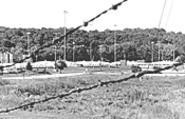Until you inhale.
One breath, and the bitter tang of human waste sets your lungs ablaze. Thanks to a sewage-treatment plant and nearby compost facility tucked inside the park's southern border, you wonder whether the area should be dubbed a national Port-o-Potty.
The odor dissuades bikers and pedestrians from heading south of Botzum Trailhead, located a stone's throw from the stench corridor along the Towpath Trail. "It's disgusting," says Cuyahoga Falls resident Sue Andrea, who bikes the trail twice a week. "You can't breathe when you go past there."
Cynics might say it's only fitting that the area reeks as though half the state forgot to flush. After all, Ohio tends to treat Mother Nature in the manner of the Turks invading Bulgaria. What better place for a sewage plant than our sole national park? Let other states boast of pristine pastoral expanses with virginal streams. We offer a river so polluted that the park bans swimming and boating. Anglers are warned that they eat the catch of the day at risk of glowing.
"It's almost like something from a sci-fi novel," says Charles Hambly of the nonprofit Cuyahoga River Remedial Action Plan. "It's like 'Come to the park, just don't touch the water.'"
In this tale of fictional reality, eco-activists cast Akron as the biggest villain. Cities from Cleveland to Cuyahoga Falls abuse the river and, by turn, the park. But it's Akron that runs the sewer and compost plants. Akron that spews raw waste into the river, owing to a sewer grid built around the time man discovered water. Akron that for decades "hasn't really acknowledged the Clean Water Act," says Keith Dimoff of the Ohio Environmental Council.
Then he unloads the stiffest criticism of all. "They're even behind Cleveland and Toledo in tackling this sort of problem."
He's referring to combined sewer overflows, a clunky technical term that roughly translates as "unfiltered crap oozing into the river after heavy rains."
Every year Akron's 37 combined sewers belch about 3 billion gallons of sewage and storm runoff into the river, accounting for more than half its bacteria. And not just the kind that cause hives. The Akron Beacon Journal reported last summer that a man nearly needed his arm amputated, after a cut he suffered while wading in the river became infected.
Such stories prompt Elaine Marsh to pack antiseptic whenever she canoes on the Cuyahoga to study its health. A romantic given to describing water as "the elixir of life," she co-founded the advocacy group Friends of the Crooked River in 1989. A decade later, she sat on an advisory panel that urged Akron to replace its aging sewers before the waterway spawned some kind of giant fecal creature.
City officials nodded at the solution, but shrugged at how to pay for the project or when to start it.
"We have a river that goes through a national park that we can't use," Marsh laments, "and we don't know when we'll be able to use it."
In fairness, Akron has coughed up $255 million since 1980 to upgrade its sewer grid and treatment plant, both of which predate the national park. It's also begun a $14 million repair of one combined sewer that spits out a third of its untreated waste. Officials contend that they'd start working on the other 36 -- if the feds would get the hell out of their way.
The city finally reached a tentative deal with the Ohio EPA last summer on a 30-year, $377-million plan to remove the combined sewers. But the U.S. EPA -- which of late appears to regard pollution as a growth market -- swooped in months later and told Akron to halve the project's length.
This ironic twist brought instant results: The proposal stalled. The city last heard from the feds in April, when it received a letter stating that the U.S. EPA needed to review "scheduling of long-term plans" and "appropriate time guidelines." In Dave Lieberth's sardonic reading, the phrases sound an awful lot like "Blah blah blah."
"We wanted to get going right away," the deputy mayor says, "but they had other ideas."
Akron jacked sewer rates 6 percent in January in anticipation of the project, boosting the average bill of residents to $24. But if the feds insist on a 15-year timetable, rates would need to double or triple to cover costs. Officials liken that prospect to a four-letter word for sewage.
"Is it worth it to be shutting off people's water when they can't afford that increase?" asks Michael McGlinchy, the city's public utilities manager. "If the federal government wants this done, they should put a little money into it."
Or, says City Councilman Daniel Horrigan, "Let us build the new system in 15 years, but pay for it in 30. It's not like $377 million is chump change."
Meanwhile, as the feds dawdle, inflation nudges costs upward -- stoking anxiety that further delays could push Akron's tab closer to the $1 billion Cleveland is paying for its sewer overhaul. Worse still, the wait could harm the Cuyahoga River, which after decades of neglect is showing signs of twitching back to life.
"I want to see this river cleaned up," Marsh says. "With raw sewage running through your city, you can't have a high quality of life."
Or much of a national park.


